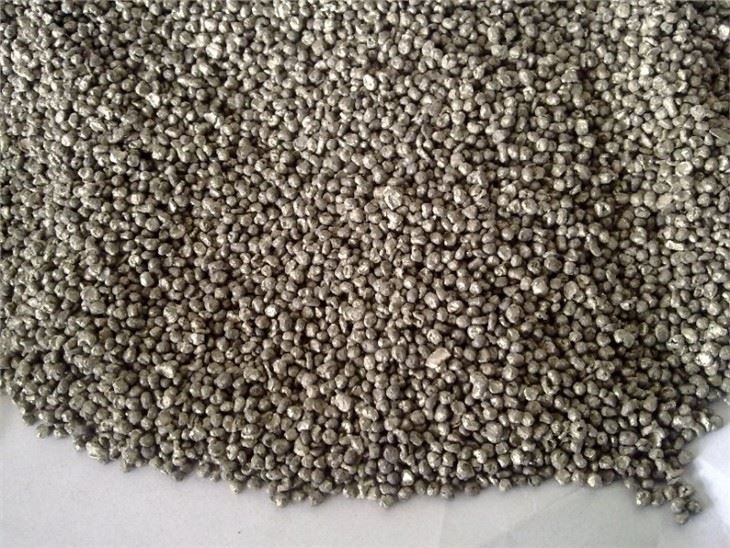
The preparation of Calcium Metal mainly includes reduction method, electrolysis method and calcium refining.
Due to the very strong activity of Calcium Metal, it was mainly produced by electrolytic molten calcium chloride or calcium hydroxide in the past. In recent years, the reduction method has gradually become the main method of producing Calcium Metal.

The reduction method is to use metal aluminum to reduce lime under vacuum and high temperature, and then rectify to obtain calcium.
The reduction method usually uses limestone as raw material, calcined calcium oxide and aluminum powder as reducing agent.
The pulverized calcium oxide and aluminum powder are mixed uniformly in a certain proportion, pressed into blocks, and reacted under 0.01 vacuum and 1050-1200 ℃ temperature. Generating calcium vapor and calcium aluminate.
The reaction formula is: 6CaO+2Al→3Ca+3CaO•Al2O3
The reduced calcium vapor crystallizes at 750-400°C. The crystalline calcium is then melted and casted under the protection of argon to obtain a dense calcium ingot.
The recovery rate of calcium produced by reduction method is generally about 60%.
Because its technological process is also relatively simple, reduction method is the main method for producing metallic calcium in recent years.
The combustion under normal conditions can easily reach the melting point of metallic calcium, so it will cause the combustion of metallic calcium.
The earlier electrolysis was the contact method, which was later improved to the liquid cathode electrolysis.
Contact electrolysis was first applied by W. Rathenau in 1904. The electrolyte used is a mixture of CaCl2 and CaF2. The anode of the electrolytic cell is lined with carbon such as graphite, and the cathode is made of steel.
Electrolytically desorbed calcium floats on the surface of the electrolyte and condenses on the cathode in contact with the steel cathode. As the electrolysis progresses, the cathode rises accordingly, and the calcium forms a carrot-shaped rod at the cathode.
The disadvantages of calcium production by contact method are: large consumption of raw materials, high solubility of Calcium Metal in electrolyte, low current efficiency, and poor product quality (about 1% chlorine content).
The liquid cathode method uses a copper-calcium alloy (containing 10%-15% calcium) as the liquid cathode and the graphite electrode as the anode. Electrolytically desorbed calcium is deposited on the cathode.
The shell of the electrolytic cell is made of cast iron. The electrolyte is a mixture of CaCl2 and KCI. Copper is selected as the alloy composition of the liquid cathode because there is a very wide low melting point region in the high calcium content region in the copper-calcium phase diagram, and a copper-calcium alloy with a calcium content of 60%-65% can be prepared below 700 °C.
At the same time, due to the small vapor pressure of copper, it is easy to separate during distillation. In addition, copper-calcium alloys containing 60%-65% calcium have a higher density (2.1-2.2g/cm³), which can ensure good delamination with the electrolyte. The calcium content in the cathode alloy should not exceed 62%-65%. The current efficiency is about 70%. CaCl2 consumption per kilogram of calcium is 3.4-3.5 kilograms.
The copper-calcium alloy produced by electrolysis is subjected to each distillation under the conditions of 0.01 Torr vacuum and 750-800 ℃ temperature to remove volatile impurities such as potassium and sodium.
Then the second vacuum distillation is carried out at 1050-1100 ° C, the calcium is condensed and crystallized in the upper part of the distillation tank, and the residual copper (containing 10%-15% calcium) is left at the bottom of the tank and returned to the electrolyzer for use.
The crystalline calcium taken out is industrial calcium with a grade of 98%-99%. If the total content of sodium and magnesium in the raw material CaCl2 is less than 0.15%, the copper-calcium alloy can be distilled once to obtain metallic calcium with a content of ≥99%.
High-purity calcium can be obtained by treating industrial calcium by high vacuum distillation. Generally, the distillation temperature is controlled to be 780-820°C, and the vacuum degree is 1×10-4. Distillation treatment is less effective for purifying chlorides in calcium.
Nitride can be added below the distillation temperature to form a double salt in the form of CanCloNp. This double salt has a low vapor pressure and is not easily volatile and remains in the distillation residue.
By adding nitrogen compounds and purifying by vacuum distillation, the sum of the impurity elements chlorine, manganese, copper, iron, silicon, aluminum and nickel in calcium can be reduced to 1000-100ppm, and high-purity calcium of 99.9%-99.99% can be obtained.
Extruded or rolled into rods and plates, or cut into small pieces and packaged in airtight containers.
According to the above three preparation methods, it can be seen that the reduction method has a simple technological process, consumes less energy and consumes less time, and is more suitable for industrial production of Calcium Metal.
Therefore, the reduction method is the main method for the production of Calcium Metal in recent years.